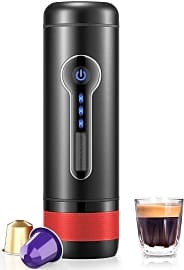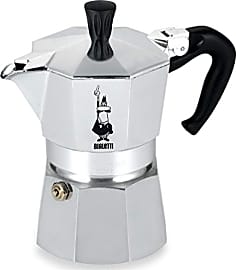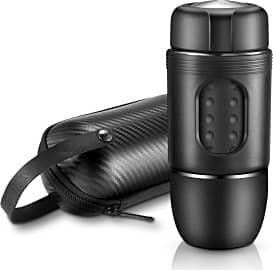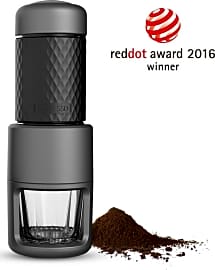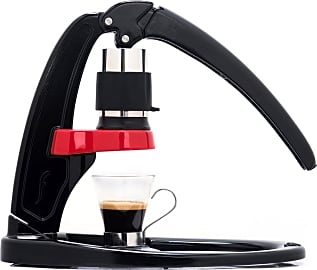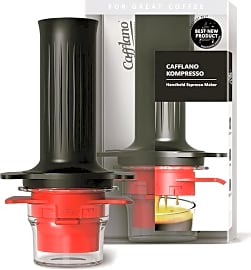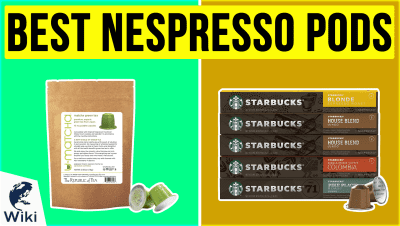The 10 Best Portable Espresso Makers

This wiki has been updated 35 times since it was first published in February of 2018. Coffee is the drink of choice for millions of people, many of whom consider it an essential part of each morning. Brewing its pressurized, steam-born cousin usually requires a high-powered machine and a bit of know-how, but if you're running late for work or waking up early on the trail, a portable espresso maker will help keep you in crema even when there's no barista within 100 miles. When users buy our independently chosen editorial recommendations, we may earn commissions to help fund the Wiki.
Editor's Notes
December 02, 2020:
We removed Barsetto Tripresso, Litchi Double-Shot, Handpresso Auto, Handpresso Wild Hybrid, and Staresso Third Generation due to availability concerns and replaced them with Cafflano Kompresso, Moocoo Manual, Staresso Mini, Conqueco Portable, and Simposh Simpresso, respectively. The Conqueco Portable stands out because it is one of the few models that heats the water and dispenses espresso automatically. If you’re someone who finds themselves on the road frequently, this is a great pick because you can recharge it in your car and because it’s small, you can easily tuck it away. However, if you want to use store-bought espresso pods, be aware that this model is only compatible with the Nespresso and L’or brands' pods.
The Simposh Simpresso, on the other hand, is compatible with most pods and your own ground coffee, but it’s not automatic so it takes a little more elbow grease. It will still make a good cup of coffee, though. Similarly, the Cafflano Kompresso requires manual pressure, but it is very lightweight and compact, so it’s perfect for backpacking.
September 24, 2019:
There are a few different basic styles of portable espresso maker. The most common is the cylindrical version, such as those made by Staresso, Handpresso, and especially Wacaco, who makes some of the finest and most compact models. These vary in their capacity and durability and in some cases how they operate fundamentally; the Handpresso Auto, for instance, plugs into a 12-volt power source and completes all the steps for you, withn no separate stove or heat source needed. You may also want to consider one that uses ESE pods, either K-Cups or Nespressos.
Aside from the cylindrical models, there are some more traditional options that are still relatively easy to take on the road. Many coffee aficionados swear by a moka pot, and while it's not technically real espresso, moka coffee is easy to make, tastes amazing, and is pretty efficient when it comes to bean use. The Flair Manual is another very simple machine, and while it is pretty heavy and requires a bit of elbow grease, it's consistently effective and comes with its own carrying case. On the complete opposite end of the spectrum is the Handpresso Wild Hybrid, which makes a great cup, but isn't particularly durable considering its relatively high price.
Joe On The Go
The pounding headaches, the fogginess, the desire to rip off the head of whoever is unlucky enough to speak to you that day...it makes me shudder just to think about it.
If you're like me and have a serious caffeine addiction, few things are as terrifying as the idea of being stuck without your daily (or hourly) java fix. People who don't drink coffee may scoff at the idea of being addicted to something so seemingly innocuous. But, while the withdrawal symptoms may pale in comparison to those associated with nicotine or hard drugs, anyone who's ever experienced them knows that caffeine dependence is the real deal. The pounding headaches, the fogginess, the desire to rip off the head of whoever is unlucky enough to speak to you that day...it makes me shudder just to think about it.
Luckily, there has never been a better time to be a caffeine fiend. Even small towns have coffee shops these days, and if yours doesn't, you almost certainly have a 7-Eleven or fast food joint that serves a decent cup of mud. If you prefer to brew your own, there's also a huge market for devices and containers designed specifically to ensure that you never have to leave the house without a cup of coffee, or hot tea, if that's more your style. The variety of shapes, materials, and colors in travel mugs is simply staggering, and you can even find some that have a French press built right in.
But, if the super strong stuff is more your speed, you can't go wrong with a portable espresso maker. Whether you're running late and need to pull a shot on your way to work, or you want something that you can take with you to a hotel or on a camping trip, there's an option out there for just about everyone.
There are stovetop models, which can also be used over a campfire, and thermos-style options that come with a cup, and sometimes a carrying case. Prefer to do things the old-school way? Then you can choose a manual, hand-pumped option. Just add hot or cold water, depending on your preference, and a little elbow grease. If you'd rather use electric power, there are plenty of models that charge via USB cables, and some can even plug into the 12-volt DC outlet in your car.
Coffee And Espresso: What's The Difference?
If you're not much of a coffee drinker, you may think that everyone's preferred brew is pretty much the same thing. But there are a lot of subtle differences, from how the beans are roasted and how finely they're ground, to the various extraction methods used at home or your local coffee shop.
Most people think of espresso as being a quick caffeine fix, but interestingly, a shot of espresso actually has less caffeine than your average cup of drip coffee.
The biggest difference between coffee and espresso is how they're brewed. Regular coffee is made by pouring hot water over medium- to coarsely-ground beans. Espresso, on the other hand, requires a much finer grind. Espresso machines are typically steam- or pump-driven to force water through the beans, producing a more concentrated flavor.
The high-pressure methods used to make espresso emulsify the oils in the coffee, creating a much thicker beverage and forming a froth on the top called the crema. The color and density of the crema is often used to judge the quality of a shot of espresso and how well it is brewed.
In terms of flavor, espresso tends to be more full-bodied and well-rounded than coffee. This is partially due to the paper filters used in making drip and pour-over coffee, which strain out a lot of the natural oils. The longer brewing time also allows more acids to cover up some of the more complex flavors in regular coffee beans.
Most people think of espresso as being a quick caffeine fix, but interestingly, a shot of espresso actually has less caffeine than your average cup of drip coffee. This is mostly because of concentration, though — a cup of coffee can be anywhere from eight to twelve ounces, while a shot of espresso is only one ounce.
A Brief History Of The Coffee Shop
A few decades ago, the idea of a business dedicated solely to selling coffee was unusual in the United States, and to many, it seemed preposterous. I can still remember my parents' reaction when Starbucks first started to become popular — "How much for a plain old cup of coffee? Are they crazy?" Today, plenty of people head to their local coffee shop every single day, if not multiple times per day, but it took us quite a while to get here.
From there, it didn't take long for the beloved hot beverage to catch on, even though the king tried to ban it at one point in time.
People have been growing coffee since all the way back to the 9th century, beginning in Africa, but it didn't make its way to Europe for another 800 years. From there, it didn't take long for the beloved hot beverage to catch on, even though the king tried to ban it at one point in time.
The first coffee houses in London were met with mixed opinions, to say the least, as they were often hot beds for political discussions. In fact, some of the ideas that formed the policies for the soon-to-be New World may have originated in these establishments. In many countries, including England and France, women were not allowed in coffee houses, leading some ladies to create mock petitions against the businesses and coffee itself. Some even dressed up like men in order to be let in.
It wasn't until the 1950s that coffee shops finally caught on in the United States. They first started to gain popularity in Italian-American communities in large metropolitan areas like New York City, Boston, and San Francisco, and slowly spread to the rest of the country from there. Then, in the 1960s, young people began to hang out in coffee shops, and many popular musicians, including Bob Dylan, got their starts performing there.
Until the 1990s, most coffee shops in the U.S. were located on college campuses and were associated with artists, writers, and other "countercultures." But between 1987 and 2007, Starbucks opened an average of two new locations per day. Today, there's one on pretty much every corner — the company has over 28,000 locations worldwide, with more opening all the time. Looks like our caffeine habits are safe for the foreseeable future.



